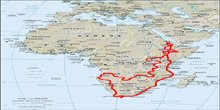There is no border post (as yet) on the Tanzanian side of the Macatchedj, the new bridge over the Rovuma River, and the Mozambiquan border control is housed in grass huts. We have to do the Tanzanian paper work in Songea, the next big town, 102km further North.
For a few kilometres we drive through virgin bush. The first villages we see have brick houses:

People also have cows, dogs, and much more material goods than we have seen in the whole of Mozambique.
 Cows and a broken bridge
Cows and a broken bridgeWe enjoy the local advertising style and spelling:

We thought we were back in English-speaking country, but everywhere Swahili (the local language) dominates. It is a beautiful language and we wish we understood and could speak a bit more. We are learning “Pole pole” (slowly slowly): “Karibu” (Welcome), “Asante sana” (Thank you very much), “Habari” (How are you?), “Mzuri” (Fine), “Wapi” (Where), and we can count to ten…
For bigger numbers we learn from the notes. The exchange rate is of 150 Tanzanian shilling (Tsh) for 1 rand (ZAR), that is about 1300 TSh to the USD.
The local cell phone networks have welcomed us. There is Tico, and Zain with its bright purple swirls.
So far we have only had one of the local beers. Not surprisingly, it is named after the Kilimanjaro. “It’s Kili time! Make the most of it.” says the advert. We follow the advice when we get to Moshi:

 Braaing in the bush after looking for a visiting elephant on TPC's land. With Fred, Caro, Bruno and Zia. And with Kilimanjaro in the background
Braaing in the bush after looking for a visiting elephant on TPC's land. With Fred, Caro, Bruno and Zia. And with Kilimanjaro in the backgroundNot only do the markets and shops offer more choice, but costs are also much lower than in Mozambique. A Coca-Cola costs us Tsh 500, a cabbage Tsh 400, an hour on the internet Tsh 1000. Our best surprise is the cost of petrol: it is closer to South African costs, under 10 ZAR a litre. In Mozambique it was between ZAR 15 and ZAR 20 a litre, much more than we had budgeted for.
By now we are used to shopping at local markets, washing our fruits and veggies in clean water before we eat them, as well wearing long pants and long sleeves shirts together with anti-mozzie spray in the evening to avoid getting malaria.
We were carrying water from Lake Niassa (Lake Malawi). We had filled our 60l tank straight from the lake one morning, and purified it with a few drops of chlorine. We ran out of water shortly after Kondoa so we filled up from a well in the mountains at Mbulu. We haven't had any tummy problems yet.
Otherwise, apart from the half-day stop in Songea to deal with the border crossing paperwork, we haven’t really had a chance to experience the Tanzanian culture yet. Generally people aren’t as smiley and friendly as in Mozambique, but they seem pretty relaxed nonetheless. Policemen haven’t cause and problems, although they always try their luck and cheekily ask: “What gift have we brought them from South Africa?” We just laugh with them and say that we’ve eaten all the Christmas cake. We would rather sit and wait rather than offer any bribes, and so far it’s been fine.
From Iringa we took the “bumpy” road North to Arusha through Dodoma and the Masai Steppe. This has allowed us to drive through isolated villages and to meet a few people along the road. To me, the most striking cultural experience so far, has been our timid encounters with a few Masai men. They are very tall and very beautiful. They also have a strange intensity about them. They walk fast in long loping steps, some occasionally ride a bicycle, and young boys herd cattle. They all carry sticks, long knives, and they all wear a blue or purple cloth/dress (different from the traditional red). We re amazed that they survive in this dry thornbush environment and look forward to learning more about them.

 Tying up the surfboards on the bumpy road through Dodoma
Tying up the surfboards on the bumpy road through Dodoma


 On the road from Dodoma
On the road from Dodoma
 Camping in the bush on the Masai Steppe
Camping in the bush on the Masai Steppe The mountain road to Mbulu
The mountain road to Mbulu  In Karatu, a fellow South African, Andre, hosted us. The two Masai men working for him were intrigued by our surf boards
In Karatu, a fellow South African, Andre, hosted us. The two Masai men working for him were intrigued by our surf boards




ayyyy me beloved Tanzania!! Imagine me in high heals in Dodoma at the Parliament,jajajaj quite a joke! Weirrrrrd capital... I hope you are still enjoying Tz. Im still impressed of my memories of Serengeti and Ngorongoro... Im getting my dirving license in order (meaning, I still have to do the exam ;) so hopefully enough, next time we meet, I WILL dirve you around :) take care guys, have fun! another words... Rafiki ( friend) safari (travel)... Looooove
ReplyDelete